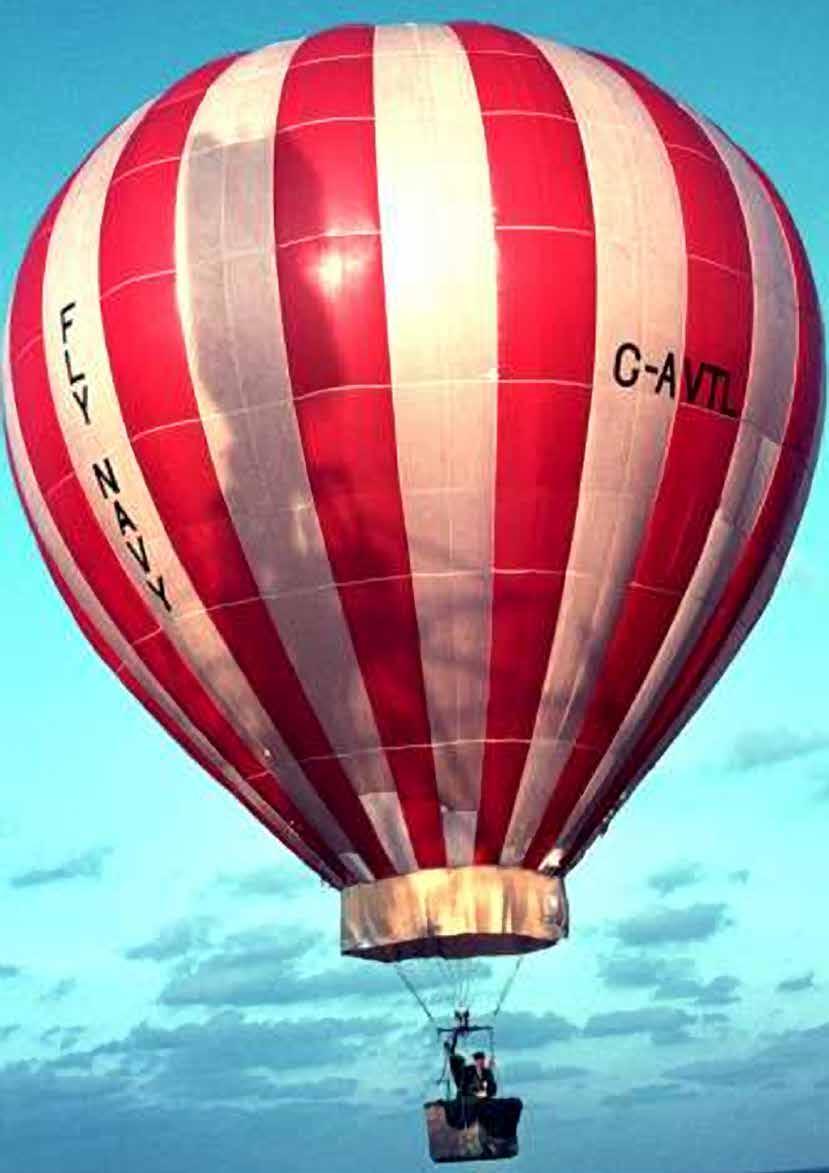
Trailrope Charity Registration Number 281331
No.129 Winter 2022 The Journal of The British Balloon Museum & Library www.britishballoonmuseum.org.uk
Issue
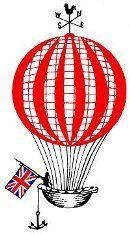
The British Balloon Museum & Library
President
Robin Batchelor
Vice Presidents
Peter Sadler
Nigel Tasker
David Hopkins
Chairman
Richard d’Alton chairman@bbml.org.uk
Vice Chairman
Jeff Roberts vicechairman@bbml.org.uk
Secretary Tim Turner secretary@bbml.org.uk
Telephone; 01933 710276
Treasurer John Crawford treasurer@bbml.org.uk
Telephone; 01628 635851
Friends Administrator Secretary Celia Kunert membership@bbml.org.uk Telephone; 01189 730454
Public Relations & Press Liaison
Jennifer d’Alton pr@bbml.org.uk
Telephone; 07778 002147
Trailrope Editor
Jennifer d’Alton trailrope@bbml.org.uk
Telephone; 07778 002147
Council Members
Dr David Bareford, Pete Bish, Dr Giles Camplin, Angela Lickorish, and Martyn Turner
Trailrope Team
Jennifer d’Alton
Nick Peacey
John Baker
E D I T O R I A L
Happy Christmas Everybody, and I hope you had a good Thanksgiving if you are one of our nine recipients of Trailrope in the US.
I have a sneaky suspicion that the postal strike might affect the delivery date, But started finishing it on Montgolfier Day, and you might get it by Christmas Eve – what fun to wake up and read this!
There s a fair bit about Terry Adams now, and over 50 years ago. Fascinating stuff.
Thank you to everyone who came to the luncheon and AGM. Also, a big thank you for everybody who has contributed to this issue. It is full of ‘firsts’.
The 1st balloon pilot to fly in all 50 states in the USA.
The 1st balloon flight from the Isle of Man.
The 1st balloon flight in Wales. The 1st balloon flight from an aircraft carrier, and the 1st Transatlantic Balloon race. Phew!
Thank you to everybody who helped me with this Trailrope.
Tim Turner, John Ba ker, Tracy Robb, Alan Noble, Sandy Mitchell, Barbara and David Davis, Nick Peacey, Anthony Fairbanks, Robin Batchelor, Ann Brown, Jeff Roberts and Celia Kunert.
I hope I haven’t missed anybody out.
I am always looking for interesting of peculiar stories, do send them to me if you find one.
Have a Merry Christmas and a splendid New Year.
Jenni
TRAILROPE is the journal of the British Balloon Museum & Library. It is published four times a year and distributed free to Friends of the Museum. Issues can be purchased from the Editor for £5 each which includes UK postage. The views expressed are not necessarily those of the BBM&L or the Editor.
If you would like to send a letter, article or photographs for Trailrope, the address is; Jennifer d’Alton, Manderville, Links Road, Amble, Morpeth, Northumberland, NE65 0SB UK Or email Trailrope@bbml.org.uk
C O N T E N T S
Editorial ……………………………..2
AGM & Andrew Holly ……… …….3
BBM&L Collection 3
1st Flight from the Isle of M an 4
1st Flight from Wales .5
1st Flight from HMS Ark Royal ..7
Jaspers Child naming ………..…..8
Chrysler Atlantic Race ……….….9
Zeppelin Museum ..10
Book’Lighter than Air’ 11
South Africa Dinosaur Derby 14
One Man Meet…………………..15
One Man Meet Photos ……..…16
2022 AGM & Annual Luncheon
Thank you to everyone who came to this event at Donnington Grove at the end of October. The weather was sunny, the meal was good, and the company was excellent It was so nice to see you all, and some people had never been before, I hoped you enjoyed it. We would like to welcome Alan Noble, Alan Dorman and Andrew Holly as new Friends of the Museum Well it is ridiculously cheap still, £10 a year for invitations to everything, and four glossy magazines.
PLEASE HELP
The price of printing Trailrope has gone up , also postage has shot up as well . We do not want to put the cost of your subscriptions up and actually you get a good deal at £10 a year. Could you possibly help out with a small donation paid through the website?
DONATIONS
GO TO WWW.BBML.ORG.UK
Thank you to everybody who has already done that The Cover.
Do you recognize Bristol Belle G-AVTL?
Thank you to Jeff Roberts for the photograph, and all the others that accompany the article about Lt Terry Adams being the only person in the world to take off from an aircraft carrier, HMS Ark Royal, in a Hot Air balloon in 1970, and fly to Malta.
Fifty States in forty-nine days is amazing, and no American has ever done it

After the lunch, Chairman Richard d’Alton, presented the David Liddiard Trophy to Angela Lickorish for her, hard work, attention to detail and enthusiasm throughout the year, and at the three main events of 2022. The Inflation Day in April, The Midlands Air Festival and then the White Waltham Air Show
Andrew Holly, Guinness Record Holder, was a welcome guest and gave us a story with a slide show that had many of us gasping. He flew in each one of the United States 50 states and created a Guinness record.
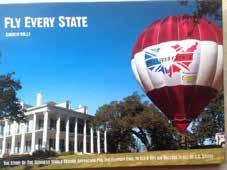
The Guinness people really made Andrew and his group jump through hoops to make sure that the record was ratified, and they did! You must see the DVD.

I know Pete Bish has got copies of Andrew’s book and the DVD if you want to treat somebody this Christmas. Just visit the Zebedee website
https://www.zebedeelist.co.uk/ Andrew very generously gave a copy of each to be auctioned and Colin Butter bid the most for them. As our museum auctioneer was receiving another award that day, John Baker took over the auctioneering and raised a lot of money for the museum. Well done John.
Jane Crawford had sold a phenomenal amount of raffle tickets, I think she sold £150 worth, and so many people had donated items, it took some time but everyone went away happy. Well done Jane.
I hope you all have a splendid Christmas and New Year, and if you get presented with a ballooning object you do not want, hang on to it and donate it for the Auction next year, Sunday 29th October 2023 at Donnington Grove, Newbury
Oh do visit our stand at the Icicle Re-Frozen also at Donnington Grove.
Jenni d’Alton
BBM& Collections Matchboxes

As you all know, the British Balloon Museum & Library collect all memorabilia to help preserve past
ballooning memories for the future generations.
But we have very few items in our matchbox and matchbook collection. I know people do not smoke much nowadays, but they used to.

Have you got any old match books tucked away in your sock or knicker drawer?
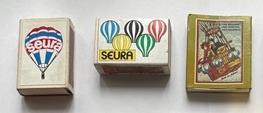
If you do find a little treasure that you would like us to preserve for years to come, maybe you could send it to our museum category holder for Matchbox and Matchbooks, Celia Kunert.
Celia also preserves all the ballooning Tee-shirt and Sweatshirts from ballooning teams and manufacturers from all over the world.
Oh yes, she is also the most amazing membership secretary for the Museum, the reason you get your Trailropes at the correct address.
An Innovative Christmas Present.

It is a super Christmas present, a subscription to the British Balloon Museum & Library. It is environmentally sustainable because you just go to https://www.bbml.org.uk/friends/ Pay £10 for your loved ones ’ present. You do not have to gift wrap it or post it. Perfect for those nephews and nieces you do not know what to buy for them.
If you encourage them to have their magazines sent to them online, it would help the Museum tremendously.
2 3
A Monumental event in Manx history took place 120 years ago, 1902
10 November 1902 was the date when the Isle of Man first witnessed a person take flight, in balloon that took off from the middle of Douglas. The story is told by Gordon N. Kniveton:
"In advance of the arrival of the gunboat H.M.S. Renard, on November 3, rooms had been booked at the Peveril Hotel and Douglas gasworks had been wired to provide 45,000 cubic feet of gas. The supply was required in Peveril Square between the Hotel and the pier buildings, which meant tapping the 12-inch main at this point. Bags of sand were also needed as were thirty unemployed men to act as 'seamen'.
On board the Renard were the two balloonists, one of whom,
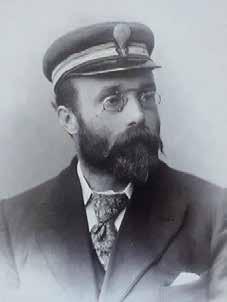
Mr. Percival Spenser, would be in charge of the operation. He was a famous aeronaut whose family specialised in the making of Spenser balloons which were based on Santos Dumont design.
Percival Spenser was accompanied by an intrepid clergyman, the Rev. J. M. Bacon. The balloon, weighing 4 hundredweights, was stored in a basket measuring 5 by 4 by 4 feet, and together with the other equipment was brought to the Peveril stables. The week passed as they waited for favourable conditions and on the Saturday and Sunday evenings the Rev. Bacon
gave lectures on the marvels of flight, at the Gaiety Theatre.
Monday, November 10, dawned bright with a light south-westerly breeze. This was to be the day and preparations began at an early hour. Sails were spread o n the ground to protect the precious oiled skin of the balloon and 45 sand bags were placed in position to hold down the rope mesh surrounding the balloon.

Then at 8.35 a.m. the gas was turned on while schoolmasters chased boys off to school. But they were soon back when permission was given; offices, shops and houses emptied when the news spread, and an estimated 15,000 gathered to view the spectacle.

T hey stood in awe as the balloon, one of the largest in existence, was slowly inflated to its capacity - 60 feet high and 45 feet in diameterwhile the net took the strain. The process took all morning and then the balloonists were seen to clamber aboard with their tackle. They were presented with Manx coins and then the porter of the Peveril handed them a bottle of rum for inner warmth on this cold November day. The order was given to detach the bags and the seamen took the strain on the tethering rope.
Then, at 1.34 p.m., Mr. Spenser called, 'Let go!' This was followed by the mightiest shout ever heard on the Island as the people cheered and wished the aeronauts 'Good luck!' They saw the giant balloon rise gently and then rapidly into the air as it sa iled off majestically across Douglas Bay, eyes straining to catch a last glimpse as it disappeared into cloud.
By 2.10 p.m. it was over Maughold Head and, as it crossed the Irish Sea, was in contact with the gunboat experimenting in signalling using drum and whistle. That night the Spenser Balloon landed in the wilds of Dumfriesshire, Scotland, having travelled 77 miles in four and a half hours."
You must read the book. 'Manx Aviation in War and Peace' by Gordon N. Kniveton, https://www.airport.im/history/firstflight/

It is hard to think back to how this must have been received by the Manx at that time, but it must have made an enormous impact on many. Of course, everything was to change the following year, when in far off North America the Wright brothers were to successfully fly an aeroplane, though nothing of that was witnessed on the Isle of Man until 1911.
The Manx Aviation and Military Museum is an essential place to visit for more of this sort of Manx history.
Thanks to Ann Brown for this ar ticle.
EUGENE GODARD & THE AURORA. The First Balloon Flight in Wales.
On the 13th. of August, 1857 a truly momentous event occurred in Carnarvon, an event which made history; but sadly is all but forgotten these days. The scene was the Castle; the time was six o'clock in the evening; the chief player was a Frenchman, Monsieur Eugene Godard, but what exactly was going on?
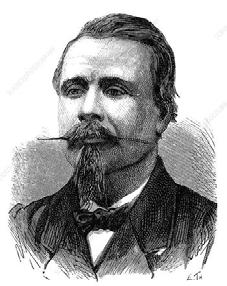
Well, Carnarvon and its inhabitants were witnesses to the first balloon ascent over Wales.
The event was part of the Royal Welsh Yacht Club Regatta. Apart from the usual races this year saw the addition of a Grand Fete inside the Castle, which attracted a large number of extra visitors to the town; so much so that special trains were laid on from Chester, Holyhead, and other towns.
The town and Castle were full of spectators, lining the pier, quay, and Castle walls, and almost every spot which commanded a view of the Straits were packed. Several flagladen yachts and other vessels lined the shore, an excellent vantage point for even more spectators.
At the end of the day's racing the events were wound up with a Duck Hunt, which created much amusement amongst the crowd. Further entertainment was provided by Rogers's Band, who were aboard a cutter moored off Porth yr Aur, and the proceedings were e nlivened by "appropriate airs."
When all the entertainment was over the large crowd retired to the Castle to witness Monsieur Godard's historic ascent.
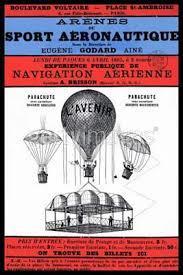
In contrast to the ever popular hot air balloons which were a common sight in France and London, Godard preferred gas balloons, and it was one of these contraptions, the "Aurora," which he brought with him to Carnarvon that day.
Eugene Godard was born in France in 1827 and made his first balloon flight in 1847 in a hot air balloon of his own manufacture.
There followed a long career as a balloonist, initially across Europe, but he slowly built up his reputation and ventured further afield. At this time he used both hot air and hydrogen balloons.
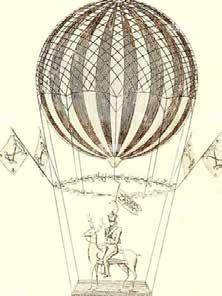
In 1854 and 1856 Godard arrived in the USA for a series of public flights, and it appears that he had a
penchant for daring acrobatics and stunts; at least twice he sat astride a horse suspended beneath the basket as well as sometimes performing gymnastics suspended from a trapeze.
He extended his 1856 tour into Canada, attempting to complete the first successful flight in that country. A few years earlier Montreal had established a reliable source of gas lighting through the New City Gas Company, which Godard used to fill his balloon.
Unfortunately his balloon was accidentally destroyed in Boston on the 4th. of August 1856 which meant that when Godard arrived in Montreal he had to employ an army of seamstresses to put together a new one.
The new balloon, named "Canada," was the first air vehicle to be built in Canada, and on the 8th. of September Godard completed the first balloon ascent seen in Canada at Quebec. Before returning to the USA he completed a further two passenger carrying flights.
So it was that Godard arrived in Carnarvon on that day in August 1857, described as "the celebrated Aeronaut." The activities had commenced early in the morning when the process of inflation was begun. The Carnarvon Gas Works had agreed to provide 20,000 feet of gas, which was conveyed to the Castle from the nearest main by a 4 inch pipe.
By half past six a vast crowd had assembled inside the Castle, and an even larger crowd had converged on the summit of Twthill, a rocky outcrop situated half a mile north east of the town, which was described at the time as "commanding a splendid panoramic view of the surrounding country for many miles." Those upon Twthill could not see the activity going on down in the Castle and had to wait until the balloon had cleared the Castle walls to witness the specta cle.
Mr. Stacey Germain and Madame Malanie performed "several comic and other songs," while Signor Wrgihtisi's act of "Balancing Extraordinaire" was greatly applauded. The concert terminated rather abruptly as the time for a firework display had arrived.
4 5
The display consisted of "signal and sky rockets, brilliant stars, superb devices, with several other projectiles forming one of the most magnificent sights ever witnessed in Carnarvon."
The noise inside the Castle was thunderous, and it was onl y with difficulty that Godard could make himself heard to instruct his team of helpers who held on to the ropes.
Finally Godard was satisfied with his preparations, climbed into the basket and gave the order to "let go."

Amidst immense cheering, and with a brass band playing him off, the gigantic balloon ascended. At first the ascent was gentle, but it soon began to rise at a rapid rate.
The Carnarvon & Denbigh Herald described the scene thus "The spectacle was a most interesting and exciting one."
The early evening having become overcast, the balloon soon disappeared into the clouds. At this height Godard found conditions to be difficult, with the dense atmosphere impeding respiration, and the cold being intense.
The balloon initially sailed in the direction of Llanddeiniolen and Llanberis but when it reached the apex of its climb the currents became "baffling in the extreme." Having been so disoriented and unable to calculate his position, he drifted for an hour or so until the clouds finally began to clear. Finding himself apparently over Parkia, and deciding that it was a suitable spot to land, he op ened the valve and "let off steam."
This resulted in a rapid descent, but missing his target he landed in the Menai Straits.
He hit the water near Llanfair Church, but upon ballast being
thrown out the balloon rose again and headed towards Llanidan on the Anglesey shore. Here it entangled itself in a tree for a time before working itself free.
A large crowd had gathered to watch the spectacle and Godard threw out ropes, but the suspicious onlookers at first refused to take hold of them.
Finally the ropes were taken and he landed safely in Llanidan Park.
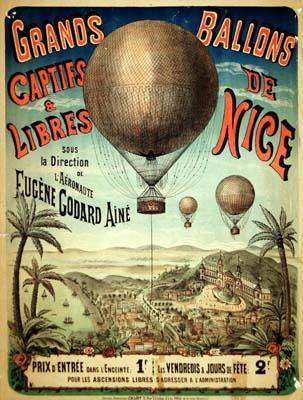
A number of those who had gathered in the park carried the balloon up to Carn, from where it was sent down to the ferry by a Mr. Parry. The whole episode created "an immense sensation" in the neighbourhood of Llanidan, but Godard was unaware of this as he was most hospitably entertained by the said Mr. Parry. He made his way back to Carnarvon that night, and was said to have been "comfortably smoking his cigar, and enjoying the company of his friends at 12 o'clock at night."

Godard continued his aeronautical career for many years, and in July 1864 he performed another, celebrated, flight at Cremone Gardens in London.
This time he flew a Montgolfier, a balloon powered by fire ( hot air). This was a giant among balloons, designed and built by himself, which he christened "The Eagle." Eugene Godard instituted the art of aerial reconnaissance in 1859 at the height of the war between France and Austria, and in 1870 he designed and built a fleet of balloons specifically to carry mail and passengers out of a Paris which was under siege. His genius was recognised by the Emperor Napoleon III, who appointed him "Aeronaute de l'Empereur," or "Aeronaut of the Emperor." He died in 1890.
So there it is, an account of an event which created a stir in Carnarvon at the time, although it is debatable whether those who witnessed it were quite aware of the historical significance of what they saw. Most probably regarded the whole event simply as a "fun day out" and would attach no importance to the spectacle, others would likely treasure the memory of the day they saw a man fly high into the sky in a balloon.
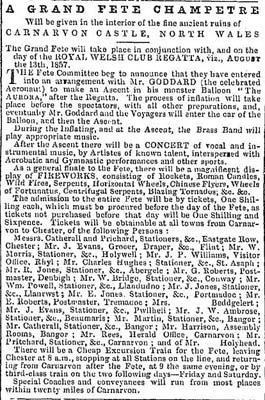
SOURCES
Carnarvon & Denbigh Herald: 15th. & 22nd. of August 1857
North Wales Chronicle: 1st. & 15th. of August 1857
‘Bristol Belle’ Terry Adams and Howard Draper in the Middle of the Med.
As recalled to the Editor, Anne Lewis Smith, for Aerostat January 1971.
On the 2nd of September 1970, HMS Ark Royal sailed from Britain for warmer seas. On board was an unusual flying machine for the Royal Navy: one elderly worn oversized laundry basket bulging with 4 x 104-pound propane cylinders and a distinctive red and white envelope. The first hurdle was behind Lt. Terry Adams.

He had persuaded the captain of Britain’s biggest aircraft carrier, all fiftyfive thousand tonnes of it, that was entirely reasonable for one of its officers to take along his balloon.
The plot thickened and Terry happened to mention to the ship’s philatelic Officer, Lt Howard Draper, that between September and January was the centenary the first balloon mail. The plan was , for the first time, to carry mail in a balloon launched at sea.
After various false starts , Sunday the 29th of November turned out to be the day
The Ark Royal and its crew of 2,500 (who by virtue of being on board were also at the launch point), lay off Malta.

On the previous day, the wind had been five knots from the NW but the Met were a little reluctant to forecast a direction for the following 24hours –and who can blame them when they were only two isobars on the chart between Gibraltar and Cyprus The laws of Met suggested a dead calm.
Hoping this would not be the case, Terry planned for a wind from the Northeast, and arranged for the ship to be positioned accordingly.
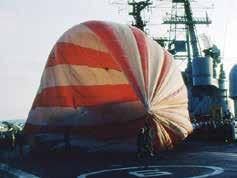
At midnight , it was one knot from the south at 2,000feet – not much help. Next briefing was at 6.00am in Sunday, and there was a wind but it was westerly, 3knots, and HMS Ark Royal was the wrong side of the island!

Fortunately, the officer of the watch had been well briefed and he arranged for the ship to steam round the north of Malta past Gozo, at all of 20 knots
Terry commanded the Ark Royal to run in towards the island from the West, giving a slight wind over the

deck to help with the inflation.
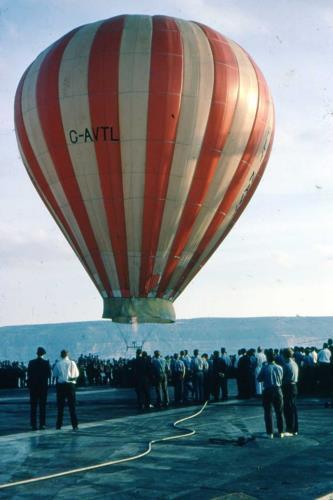
Launch took place at 0755 hours and a rapid climb was made. T here were too many dangerous revolving nodding radar emitting aerials on the ships for comfort.
Apart from the balloon mail, they also carried VHF radio, flags (Union Jack and Maltese), maps etc and champagne.
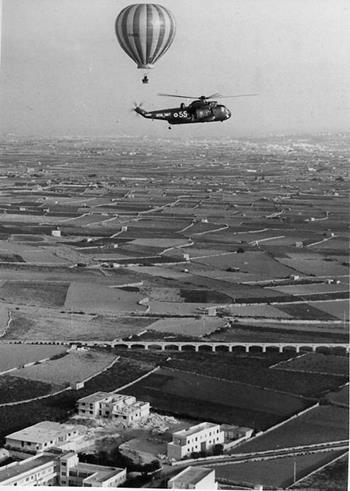
The accompanying helicopters (courtesy of the Royal Navy ) carried pressmen and they had a hard time catching Bristol Belle which by now was at 2,500feet and gently drifting towards M’Dina some five miles to the east. The wind at the launch was 260degrees, 5 knots, but slightly greater at height. Both flags were hanging limply below the basket and all was under control.
6 7
As they approached the coast, it was apparent that the wind had changed and Belle was now following the coastline, half a mile from the shore
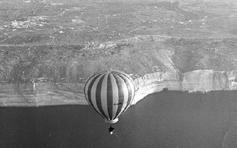
Terry burned some mo re and they ascended a further five hundred feet. Their height was checked by the helicopters whose crews had already appreciated the balloon was drifting off the coast and who were awaiting further developments with a quiet chuckle. If the crews thought t he balloonist were waving rather vigorously it was because they were trying to fan themselves over the coast!
Passenger Lt Howard Draper, on his first balloon flight, continues the story.
“As it happened, the extra height did the trick. We found that puff of wind which turned us in over the coast opposite Qrendi, adjacent to Luqa airfield. As the coastline passed beneath the basket, Terry commenced a rapid well controlled descent.

What a wonderful sensation, the surface zooming up had a 3dimensional appearance. People waving now and a great feeling of elation that we were going to achieve the flight. No fear of ditching now. Just pick our landing site.
I remembered Terry saying our forward speed was more than he thought it would be. We kept a good look out for Telegraph poles and wires, over a barbed wire fence - pick a spot between those 5-foot brick walls which
covers the countryside of Malta and we were down! Hang on tight for a fir st ever landing. A good bounce, a further drag of some fifteen feet and we were there as the basket tipped over just ten foot short of a 6-foot drop into the next field.
What an experience.
“Are you alright?” asked the Maltese farmer as he peered in to the basket. I gather most trips end with such a question. We were fine. So was the mail, and a bottle of champagne which was unbroken, tucked in my trouser pocket. “
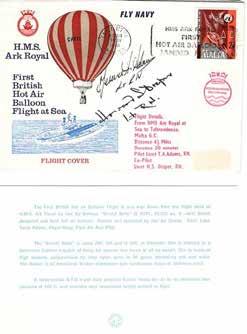
After packing up the balloon Terry got a lift to the GPO in Valetta and posted the four thousand covers they had carried which received a special one-day franking.
The postmark is timed at 0830 just five minutes after Bristol Belle had been the first hot air balloon ever to land on Malta’s soil.
Thank you John Baker for finding the relevant Aerostat.
Thank you Jeff Roberts for the amazing album of photographs .
THURSDAY’S CHILD The
Jasper Balloon Group
When I heard that Mike Kendrick’s book was called Thursday’s Child, remembered that my Uncle was part of the Jasper Group who owned a balloon with the same name. I had to ring him up.
The Jasper Balloon Group was formed by Roy Midwinter Chairman of Midwinter Pottery which was by then part of Wedgewood.
This is why they became the Jasper Group after Jasperware, the secret Wedgewood process.
John Burrows was able to tell me that the group consisted of himself, Roy Midwinter, John Waller (also a potter), Fred Holdcroft (an engineer), and Simon Faithfull.
The balloon’s maiden flight was in September 1971 from John Waller’s garden in Muckleston Woods, Stoke on Trent.

Thursday’s child was a Western balloon, the construction number was 6, and the registration was G- AZBX. This balloon was one of a couple attempting to be the first to fly over Snowdon in April 1972. Terry Adams in Serendipity was the other balloon. They didn’t quite make it as the winds took them over the southern flank of the mountain.
Thursday’s Child flew at var ious gatherings, Stanford Park April 1972, Cirencester June 1973 Cannon Park May 1974. They organised the first provincial meeting in Cheddleton i n October 1973. Not only did the Jasper group organise balloon meets but also social events as well. A dance held at Seighford Hall, with floodlit tethers on the lawns was a sell out.
They kept a list of all the places they landed with the farmers and andowners and then sent them an invitation. Their Farmers night was an incredible success with all farmers were invited for free beer and food, and by the end of the evening more than one farmer was anxious to have a flight.
They sold the balloon to Mike Kendrick in 1974 and the group all went their separate ways.
I just thought you would like to know all that little bit of history.
Chrysler Transatlantic
Balloon Race
From Alan Noble
Thirty years ago on 16 September we launched the Chrysler Transatlantic Balloon Race. The balloons took -off from Bangor, Maine, USA very early morning.
To celebrate this historic event the British team of Don Cameron and Rob Bayly organised a luncheon and kindly invited me, Project and Flight Director, and Jim Howard, Launch Master, to join them.
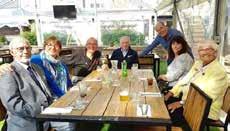
Cameron had failed in his 1978 attempt, landing in the ocean within sight of France. Ben Abruzzo, American co-pilot Richard Abruzzo's father, was the first to cross the Atlantic in a balloon when he took off from Presque Isle, Maine, in 1978 and flew to Normandy, France, setting the world endurance record at 137 hours aloft. In 1984, Joe Kittinger became the first man to fly solo across the Atlantic when he took off from Caribou, Maine. He landed 86 hours later in Italy.
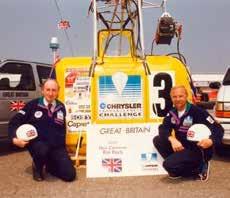
In 1987, Richard Branson and Per Lindstrand became the first to cross the Atlantic in a hot-air balloon when they took off from Sugarloaf Mountain in Kingfield, Maine. They landed in the United Kingdom less than 32 hours later.
The Chrysler Transatlantic Challenge
Sept. 16, 1992. Bass Park, Bangor, USA
"It's ballooning's greatest race ever." Don Cameron
The scene at Bass Park the night of Sept. 15, 1992, was, in a word, aweinspiring. Five teams of balloonists from five countries set out that clear and cool late-summer night to embark on a trip few had taken before or have taken since.
Conceived in 1982 by worldrenowned balloonists and balloon manufacturers Don Cameron and Alan Noble of the United Kingdom, the Chrysler Transatlantic Challenge pitted the world's best ballo onists against each other in a race across the Atlantic Ocean to the first paved road in Europe, excluding Ireland, almost 3,000 miles away in the shortest elapsed time. The second goal of the race was to see which team could stay aloft the longest. The flight over the Atlantic was so dangerous that only five previous balloons had crossed the ocean successfully in sixteen previous attempts, with three attempts ending in death.
word of the impending launch spread, curiosity seekers from around the state travelled to Bangor to watch the start of the race. Despite its being a school night, parents brought their children to marvel at the balloons as the balloons inflated slowly before towering almost nine stories over the Bass Park neighbourhood.
To make the race truly a competition of skill among the pilots, the teams had an identical budget of $300,000, identical equipment and identical weather reports at their disposal. However, although the teams would share their position to each other, they would not share information on their altitude because the successful team would be the one that found the right altitude to pick up the jet stream's powerful winds.
In mid-August, the two -pilot teams from the United States, United Kingdom, Belgium, the Netherlands, and Germany arrived in Bangor to wait for the favourable late-summer winds that would give them their best chance of making it to Europe.
On Sept. 13, organizers reported happily that a favourable weather pattern was forming to the west of Bangor that would, if conditions held, take the balloons over the Atlantic safely. The weather held and organizers announced two days later that the launch would be at about 3 a.m. that night, about three hours earlier than organizers had envisioned
The five teams retrieved their equipment from a hangar at Bangor International Airport and began preparing to fill the balloons with helium.
After another weather briefing for the teams ended at 10:45 p.m., race director Noble announced: "We've just had a weather update. We'r e going to fly."
At 11:30 p.m., the pilots and their support crews lay their 90-foot nylon balloons on the infield at Bangor Raceway and began pumping helium into them, a process that would take about three hours. When
The 5-foot-by-5-foot-by-7-foot Kevlar and carbon fibre gondolas weighed only a little more than one hundred pounds. They contained a global positioning satellite receiver, a fax machine so the pilots could receive weather reports, two -way radios, food, a portable toilet, oxygen and helium tanks, a parachute for each pilot, a life raft, and an emergency beacon. The gondolas themselves were seaworthy.
A crowd of more than 2,000 onlookers surrounded the racetrack or watched from the grandstand as the 3 a.m. launch time approached. Some onlookers took the opportunity to get within a hundred feet or so of the balloons as crews rushed to make last-minute adjustments and load equipment such as oxygen tanks and food.

Finally, at about 3 a.m. Sept. 16, the Belgian team launched first. With a little more than a few blasts from their burner, the Belgians and their balloon rose from Bangor Raceway slowly amid waves and cheers from the crew and onlookers before drifting to the east over Buck and Lincoln streets and then floating away into the night sky. The team's national anthem played as the balloon lifted off. The other balloons followed in five- minute
8 9
Photograph by Trevor Bartlett at the Cirencester meet in 1973
Picture shows, left to right, Jim Howard, Jan Bayly, Rob Bayly, Don Cameron, me standing, Maggie Cameron and Rona Howard. I'm now in early discussions with a world leading balloon company about organising a second Transatlantic balloon race. Fingers crossed.
intervals, each with their own national anthem to send them off.
In the first day aloft, the teams travelled only about 10-15 mph at an altitude that varied fro m five hundred feet to 1,000 feet as they left the coast of Maine and headed over Newfoundland.
Thirty-six hours after the launch, the United States led about 460 miles from Bangor and 160 miles south of Nova Scotia. The Netherlands, United Kingdom, Belgium, and Germany followed the Americans in order.
About 60 hours into the race the Belgians had moved from fourth place to first, dropping everybody else a spot. Although the weather over the Atlantic was favourable, the five balloons continued moving s lowly along the jet stream.
At 3 p.m., Sept. 18, the Dutch and British were within seventy-five miles of each other. The Belgians continued to lead, about 1,100 miles from Bangor and 250 miles off the coast of Newfoundland. The average speed of the balloons had increased from 15-20 mph at the start of the race to about thirty knots.
The Germans became the first team to drop out of the race when they ran into a storm on Sept . 19 and had to ditch their balloon 550 miles off the coast of Canada. At about that time, the Belgians had thoughts of trying to break the endurance record in addition to winning the race. Two days later, they won when they reached Portugal at 3:48 a.m. -- 2,580 miles from Bangor and 114 hours, 27 minutes after launching. They landed at Peque, Spain. The second-place Dutch almost made it to land, but they had to ditch their balloon in the English Channel, after running into foul weather.
The British team of Cameron and Rob Bayly overtook the Dutch and finished second when they landed in Figueira da foz, Portugal, after 128 hours aloft.
The Americans, meanwhile, found themselves too far to the south after manoeuvring their balloon away from the bad weather off the coast of Europe. They soon turned their apparent misfortune into opportunity by deciding to forge ahead to Africa to set new endurance, distance records, and become the first to pilot a balloon from North America to Africa.
Crowds turned out in droves thirtyfive miles east of Casablanca in Morocco when word spread of the Americans' impending arrival. The
Moroccans treated the Americans like royalty when the Americans' balloon landed. For Abruzzo, setting the endurance record at 145 hours held special meaning because his father had held the previous record of 137 hours, 5 minutes, and 50 seconds.

Pleased with the race's success and worldwide popularity, Noble said he hoped to return to Bangor the following year for a second transAtlantic race. Unfortunately, the expensive nature of the race has kept the balloons grounded even though interest from balloonists is high. Chrysler underwrote the entire $2 million cost of the 1992 race.
© 1995-2012, Ryan R. Robbins. All rights reserved.
‘Sorry we cannot come to the luncheon, we will be in Austria and Germany.’
Barbara and David Davis were looking at Airships.-Well nearly, they visited the Dornier Aircraft Museum at Friedrichshafen Airport which was very good, this is where the current Zeppelin airships live, but they were behind shut doors.
Numerous, intricately detailed models and unique original exhibits, films and photos trace the varied history of airship travel. From the beginnings of the Montgolfier brothers with their hot-air balloons at the end of the 18th century to the Zeppelin NT of today, visitors learn everything about the
eventful development of airship aviation, accompanied by setbacks and triumphs, from the beginnings to the present day. Unique exhibits tell exciting stories, such as spectacular journeys across the Atlantic, the round-the-world flight or the polar flight, document the euphoria and illuminate the creation of legends around the giants of the air.
Inspired by the collector's cabinets of the 16th century, cups and plates, tin zeppelins and coins, zeppelin sausages, zeppelin alarm clocks and airship ashtrays are on display here. Visitors cannot only marvel at the diversity of the Zeppelin cosmos, but can also view and explore 24 of the 350 exhibits more closely via iPads.

Barbara and David could not see the date for the musical, but if it is as popular as the Great British Bake-Off Musical, it will be a great success.
There was also a section where you can learn about the physical basics of airship technology and try them out by yourself. Discover, why a gas balloon rises, how airship gears and engines work or what role materials and the streamline shape play in airships. Each experiment is related to an historical exhibit.
Looks like a trip to Germany is on the cards.
Thank you David and Barbara.
Lighter than Air by
Stephen Wilkinson. A.F.C., F.R.I.B.A., Late R.F.C., R.N.A.S. & R.A.F. by Robin Batchelor.
It was 1980 when Don Cameron wrote his book ‘Ballooning Handbook’ and I went straight out and bought a copy. The first chapter was entitled ‘Fundamentals of Ballooning’ and within a few pages Don included some pages from a book published in 1939 called ‘Lighter than Air’ by Stephen Wilkinson. Price six shillings.

An informal and often irreverent memoir of the author who eventually became a balloon instructor in the Royal Flying Corps. "On September 6, 1917, I suddenly received instructions from my O.C. (he of exalted rank but of solid bone head) to take up certain instruments in a balloon to the "highest possible" for the purpose of testing the accuracy of the same." The outcome was dramatic.
The author was born on 9 April 1876 and upon the outbreak of the First World War in August 1914, was a 37 year old architect living and working in Calcutta, India with his wife and two young children.
Despite having neither the need nor the requirement to enlist in the forces, he hastened to do so, sailing with his family to England, where he joined the Royal Flying Corps tr aining as an Equipment Officer.
“I sailed on the S.S. City of Poonah for London. This was the last ship to leave India on which women and children were allowed to sail, as the submarine menace had by this time
become so serious that restrictions were made accordingly. ‘Von Tirpitz' period of frightfulness was in full blast, and there seemed every possibility of some kind of excitement before the end of the voyage. ”
Finding that he lacked the motivation and patience for this role, he was reassigned as a Kite Balloon Officer, and following training was on the point of being deployed overseas with a Kite Balloon Section as an observer, when last minute good fortune dictated that he replace a free ballooning instructor who had died in a crash.
“News came o f an accident to one of the free balloons, the pilot and crew being very badly damaged. During a night flight the balloon, after being ripped and landed, had been caught in a very strong wind and dragged over the ground, eventually to fall over the high cliffs on the coast of Wales, and the pilot received such injuries that he shortly afterwards died from the effects. Major P. asked me if I would like to fill the vacancy…”
“If someone had told me I would spend a greater portion of my life piloting balloons over such sanctified preserves as Buckingham Palace, Windsor Castle, and the grounds of many hitherto unknown - at any rate to me - parks and mansions of the noblemen of Great Britain, I should at once have suggested a visit to a mental specialist.
Such was the case, however, and it is about my four and a half years' service that propose to write. In this time I made no less than two hundred and forty-six flights from London and district in lighter -than-aircraft (Balloons and Airships), “
Remaining in England for the duration of the war, he served as a balloon pilot and instructor, making a number of memorable flights and enjoying some interesting experiences found in this autobiography of 203 pages illustrated with black and white plates and line drawings. He was awarded the Air Force Cross in June 1919 for his valuable wartime service during 1914 - 1918. From 1927 to 1941 he was Lancashire County Architect and died in 1962.
Here’s taste of his writing style and some of the antics he enjoyed during his service career as a balloon pilot !….
“Unknown to my passengers, decided to make the attempt to cross the Scottish border before we came to earth. During the filling process the breeze freshened in an alarming manner, and the huge balloon was
being held down with the utmost difficulty, and at times the envelope actually touched the ground when swaying in the wind. Not- withstanding the great number of ballast bags filled with tons of sand, the gas -bag was continually making great leaps and bounds over the ground, rising at times to about twenty feet. To help the men in rigging and "holding down 33 preparatory to flight, about 200 R.E. men were requisitioned and two more guy- ropes attached with releasing hooks to be operated on the word "let go ".
During a lull in the proceedings I took over and told the crew to get into the basket with me. Being mostly Officers from the Grand Fleet, no time was lost, which was more than fortunate, for before we could get properly weighed, a terrific wind s wept the ground and the balloon became so violent in its antics that the R.E. men got "breeze up " and let go the ropes. We whizzed over the ground, laden with superfluous ballast, and making straight for a large block of buildings; but there was no "breeze up among the sailors throwing out bags to give us "lift", and we cleared the buildings by about ten feet, but managed to take a flag-pole off with the basket as we passed by. The pole snapped off like a carrot and fell with a clatter below.

Luckily the appendix of the envelope had successfully opened, and for the time being all was well but we had lost a great deal of ballast and shot up to over 9,000 feet, and well above the layer of thick clouds and mist obscuring the earth below. I had now plenty of time to think out a plan of action, and in a short time the basket ceased to oscillate and we were at peace, travelling along in silence at a terrific pace. In about twenty minutes' time I decided to come down through and find our bearings by map and com- pass. To my astonishment we were well away and some 60-odd miles north of London, and at times must have been travelling 70 to 80 m.p.h., which promised well for the attack on Scotland.
There were, however, many conditions to be taken into
10 11
consideration if a high altitude was to be maintained and speed continued, and the weight of eight passengers in the balloon would soon cause us to descend, and the only way to keep height and speed was to drop a passenger. To do this at the speed we were travelling seemed an impossibility, but I determined to try it, and one of the "Grand Fleet" was only too glad to make the attempt and, if possible, keep a "date" he had in London that night.
Careful manipulation of the valve and a search for a sheltered spot in a valley was the next effort, and by taking the basket through a. stiff hedge or tree the job might be managed.
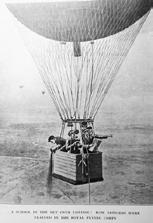
After much searching and fixing a gliding angle we found a suitable place, and I managed to take the basket through a stiff hedge and th e sailor dropped off the edge in a field near Stamford in Lincolnshire. This was most beautifully done, and the jump was made at a height of about three feet during a slight stoppage after passing through the hedge. The "Grand Fleet" rolled over on his back and waved a cheery farewell as we shot up to 6,000 feet as a result of this loss of " ballast ".
Our altitude was now all that could be desired and there was a wind of great velocity, so we did not come down until well over the Humber past Hull and wer e making excellent progress, when the wind began to blow slightly from the west and I realized that to make Scotland was impossible. I tried all altitudes and every possible manoeuvre to recover direction, and though I did at times succeed we had drifted gradually to the east coast, and if we were to continue our flight the final descent would be in the North Sea somewhere north of Whitby.
The wind above also began to decrease but the ground speed was well over 60 m.p.h., and the possibility of being able to land ANYWHERE without serious consequences began to arise with alarming suddenness.
We had seen the other balloon "land" (??) at Cranwell aerodrome we saw the basket crash into the wall of a
small building, and dragging off half the roof, break awa y again and continue to drag the basket with its occupants for about a mile over the fields, and we were all devoutly thankful we were not in that balloon.
This landing acted as a warning to me, and I had no idea of landing anywhere but a sheltered valley if possible. For many miles I tried in vain to find such a place, but our speed was too great to attempt to land and there always seemed to be some obstacle ahead in direct line of flight in the form of farm buildings or other equally uninviting full s top. We continued our mad and helpless flight until well north of Scarborough, when the situation began to become desperate, and there was nothing for it but to land anywhere and anyhow. Failing a speedy landing we were "for it " in the North Sea, and unless speedily rescued by some passing boat, should all be drowned and "Balloons, One" struck off the active list I prepared to land as soon as we were well clear of Scarborough and let down the 300 feet of trail-rope in the hope of it catching in some tree or obstacle and reduce our speed. Weather conditions began to assume that "East Coast Complexion of sea roque, drizzling rain and gloom, and with Whitby and the chill North Sea looming ahead, there was an ominous silence in the basket
The huge gas - bag was flapping about above and breaking the silence in a dismal manner, and at 300 feet we had lost all our ballast and gradually descend- ing at a terrific speed-falling like Lucifer, certainly in our case-never to rise again. The trailrope was whistling over the fields and hedges with occasional jerks and tightenings as it momentarily caught in gates and hedges. We were now whizzing over the heather -covered Yorkshire moors, and the prospects of a tolerably safe landing became more possible, when there was a sudden stoppage which upset all my calculations. The basket shot out at right- angles, whilst the envelope filled with wind and tried to form a parachute in the top of the net, and there was a pile of bodies at the bottom the basket. was the first to "break away" and look over the side to see what had happened. found that the trail-rope had become securely lashed round the trunk of a large holly-tree growing about six feet away from the edge of a deep stone quarry, and we were temporarily suspended about 500 feet
above the earth below. Fortunately the rope had completely knotted itself round the tree (discovered afterwards) and fortunately held and did not break under the terrific strain. The parachuting envelope helped to add to the pull, and it was impossible for this state of a
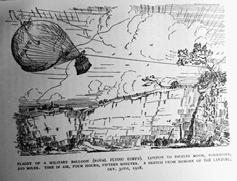
ffairs to last more than a few minutes. The tree began to slowly come away from the earth, and we plunged and yawed about in a most alarming manner -at times we went down to within fifty feet of the ground below, only to be shot up again to the extreme length of the rope, which threatened to wrench the tree out with its roots. It was during one of these upward rushes that the tree did actually come away, and at the same time bringing tons of stones and earth clattering down into the quarry below. We were loose and off again all the time rapidly descending, but this time with a glorious improvised anchor and drag in the form of the holly-tree, which crashed and bumped into every obstacle in its path. We had clear country ahead now, so I threw out the grapnel and awaited results. We travelled for a few miles when a small gamekeeper's hut came into view and directly in our line of flight, and we made a glorious" direct hit " broadside on to the hut. The effect was astonishing, there was a terrific crash and the air filled with broken bottles (empty whisky bottles they proved to be), and a small rusty iron stove made its first solo as an aeronaut, as the basket went clean through the hut.
As we struck I pulled out the rip panel, and after about 100 yards of dragging we came to rest on the soft heather at Bickley Moor in North Yorkshire, having travelled 220 miles since we took off in London earlier in the day. We left the balloon where it lay to be packed next morning. Friendly farmers came to the rescue and we spent a most festive night in a farm- house, where we were shown what Yorkshire hospitality really meant. Next morning, after packing the balloon, we took it by road to the
nearest station and left for King's Cross.”
We are beginning to get the stamp of the man and his wonderful powers of description . Here’s his recollection of a forced landing in Sussex…. ”The very next day. One Saturday afternoon, partly owing to bad gas and lack of experience, I was forced to land at Petworth in Sussex, and this landing was one of the most disastrous I ever experienced and resulted in serious damage to myself. We were at 4,000 feet when for some unknown reason the balloon began a terrific rush to earth, and though we had several bags of ballast, which we threw out at once, we could not check the rush, and at one time really thought the envelope had split. We threw out everything we possessed, including leather coats and even the carpet, but there was no checking the mad rush, which increased in velocity, and the ear th seemed to be flying up to meet us at a terrific speed, when, a frozen pond or large sheet of water came into view and we dived straight into this with a terrific crash and report which could be heard for miles around.
Sheets of ice as large as a room flew up into the air, and as I had not completely ripped until the actual crash, we at once shot up into the air for about one hundred feet, to fall again to earth like a stone, and this time with a sickening and never -to-beforgotten thud. There was a great amount of ground wind and at last came to rest with all of us feeling more dead than alive.
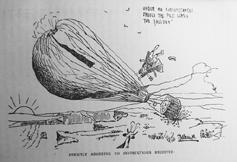
During the crash and general mix -up I fell foul of the grapnel, and one of its barbs went through my knee, luckily not doing as much damage as under the circumstances -it ought to have done, and it was surprising how little the wound bled-but returned to London with eleven small rivets in my knee, which had been fixed by the local doctor, forming a neat line from immediately below the kneecap and continuing downwards for about six inches. was taken away from the scene of the crash in a milk cart filled with straw, and suffering, in addition to
my knee damage, from very bad concussion. The other members of the crew did not seem to have been damaged at all, but this is explained by the fact that they were able to hold on to the lifelines and generally save themselves, whilst it was my job to attend to the rip, make every effort to minimise the disaster and somehow manage to bring the balloon to rest.
Naturally in a small place like Petworth, it was an event and a kind of field day, and there was a large crowd at the scene of the crash. Now among those present was a very old friend of mine whom had not seen for over twenty years; and this was the late E. Boyce-Podmore. A famous man in the world of sport, and past Master of the Vine Hounds, also a celebrated coach-owner and driver, not to mention his yachting fame. Podmore was the owner of the famous "STAR coach and four, which he drove to the second on time from Coventry to Warwick, and it was said that the villagers used to regulate their clocks and watches by the passing of the "STAR".
“Poddy" lived up to his sporting reputation, and we could not have been in better hands, and my only regret was that was feeling so ill and dazed and knocked about that could not appreciate all his "goodness and loving kindness". This Good Samaritan took us all in and really "did for us ". He poured in real oil and wine (the latter being Lemoine of a most excellent vintage). This was during the period of the war when rations were very short indeed and restrictions were being rigorously enforced, yet have visions of roasted chickens and golden- necked bottles of "bubbly" and a cheery time all round. A few days afterwards I received the following letter, which I think is worth re- producing, as it shows the nature of the man who had so kindly entertained us :
“It is always a pleasure to entertain good sportsmen in my house, and think the greatest compliment my ladies maids ever paid to me was the way they showed they could rise to a difficult position without any fuss or showing any excitement. had the servants before me after I got back from the station and congratulated them on their conduct. Mrs. P. says it is all very well, but if your party had been women instead of good-looking men they would all have resigned."
He ends the book in typical modest style and his traditional humour…
“My four years of "service" had not
been without interest and adventure. I had made many new friends, and have the satisfaction of having ‘done my bit’ -however "tin- pot" it may have been in comparison with the great War-time heroes who achieved distinction.
My personal injuries -scheduled in true " Ack. E.O." STORES "form were as follows:-
Noses (broken). One only (eventually proving to be an improvement to my personal appearance)
Knees fractured. One only.
(Mended with No. II rivets of aluminium alloy)
Pelvis (damaged and crushed) One only.
Thighs (damaged and crushed ) One only.
My appearance in "civvies " was as alarming as anticipated. It took me a long time to get to a watch and chain in lieu of the wristwatch, and it seemed odd to again take one's hat off to a lady instead of the long familiar salute.
My gratuity, which had so often trembled in the balance, came along in record time, and disappeared with equal rapidity.“
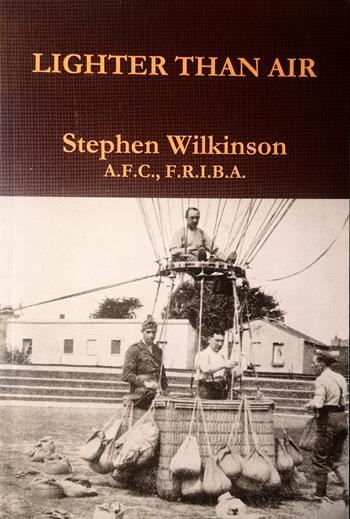
If you want a first edition of this wonderful book, GOOD LUCK! Its price will be £100 upwards - and that’s if you can find a copy. But a modern reprint is available at Cross & Crockade for £9 + P&P.
https://www.crossandcockade.com/st ore/product.asp?id=469
Review by Robin Batchelor
12 13
South African DINOSAUR DERBY!
November 19th 2022
The average hot air balloon consists of an envelope, which is used to contain the hot air , and a wicker basket, where passengers and a means of creating hot air are typically housed. But that being said the ballooning community are not always happy to be conformists, this was very evident on Saturday evening when some iconic balloons were unpacked for the first time in many years.
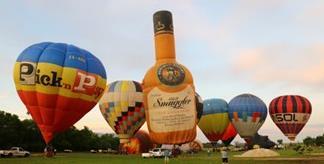
Many of these balloons had to be grounded as they were donned with liquor advertising that was banned in South Africa many years ago , others just reached the end of their safe life. Dale de Klerk CEO and accoun table person and Tracy Robb Chief Pilot decided to gander through the storage area at Bill Harrop's Balloon Safaris and came across these iconic balloons that had been forgotten about. They decided that they would use Montgolfier Day to showcase these masterpieces under the banner of the Great Dinosaur Balloon Derby.
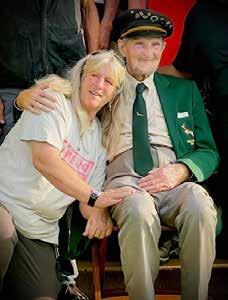
settled he started Flamboyant Balloons
Terry first began ballooning in England in 1969, emigrated to South Africa in 1976 and started Flamboyant Balloons. In so doing, he got ballooning off the ground in South Africa, building over 50 balloons.

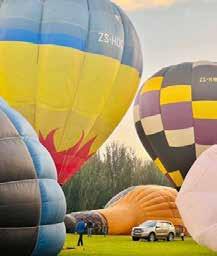
Not very often the BBM&L gets the opportunity to report on a One Man Meet (OMM) and no, we didn’t have any direct BBM&L participating balloons , but there were a number of vintage balloons attending so thought they were worth reporting on!

Furthest travelled prize went to Robert Worsman having come all the way from the Aberdeen area – what a commitment to the OMM !
as daylight started to fade, right on sunset – quite a feat!
When Terry emigrated to South Africa, he brought with him the last production Western Balloon. Many of the balloons were designed and built by Terry, regarded as the father of hot air ballooning in South Africa. Once

Tracy Robb, who is by far the most experienced balloon pilot in South Africa with well over 4000 hours, decided to try out one of the treasures found in the storeroom. The contraption is known as a hopper and is a single-person balloon. The pilot is strapped to the gas cylinder and burner by a harness system that would be at home in a WWII fighter aircraft.
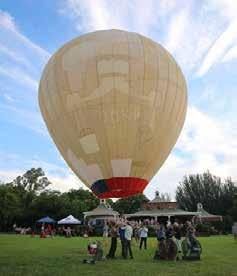
Once the rather small balloon was inflated Tracy slowly drifted off the ground, she was tethered as the balloon is no longer classed as airworthy.
Once she landed a few other brave pilots took the opportunity to fly this small piece of ballooning history. Once night fell the real visual treat started with the fourteen balloons all fully inflated and tied down treated the visitors to a night glow demonstration that will not be riva lled for many years.
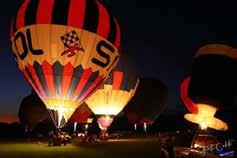
Terry stood on the balcony staring at all the balloons with pride, proudly wearing his green and gold “Springbok” colours that he achieved many times over during his amazing career.
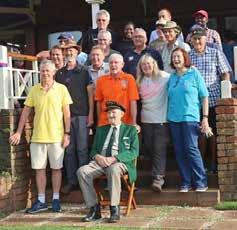
Amongst his most memorable achievements was launching his balloon from the Ark Royal – a British Navy aircraft carrier – and landing in Malta in 1970. (which is documented on previous pages in this issue.)
Sources; PilotsPost za Flight-line Weekly Tracy Robb
At the first briefing, a round of three cheers was instigated by John Tyrrell, in acknowledgement of Phil Dunnington being the founder member of the event, whilst having sadly passed away last November ,
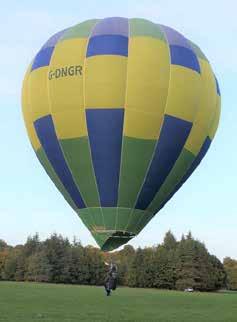
Phil is certainly not forgotten! Council Member Martyn Turner participated with his own balloon G-DNGR with a 15 minute hop within the grounds of this wonderfully picturesque Bathurst estate near Cirencester !
The OMM event has been organised since 2015 by John Tyrrell and Wendy Rousell who are no strangers to putting an event together and balloonists were welcomed to Cirencester with a sunny weekend, unfortunately t he wind proved a problem, especially at 500 feet plus, so it was a bit of a ballooning waiting game – nothing unusual there then!
Just the one slot eventually made itself available when 29 balloons took to the sky on Saturday PM! Of those dlaunched, seven were built on, or before the year 2000, that makes them at least 22 years old , with one as old as 43 years (they should be in the Museum suggest!).
The oldest balloon from the ‘oldies’ was G-BHEU (16th October 1979) called originally called ‘Polomoche’ but more recently named ‘Green Mix’ and attended this year’s Inflation Day in April and Ragley Hall in June!
However, the balloon causing the greatest interest amongst the photographers was G-BICM with ‘The Avon Advertiser’ artwork , first seen by myself at Mar sh Benham in January 1981 (registered 1st September 1980) !

G-BOYO (27th September 1988) manage
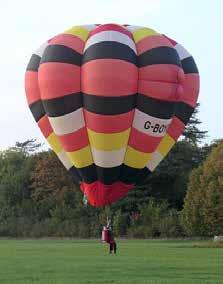
to ‘fly’ down the length of the central avenue of trees of the estate landing

G-BWOY a Sky 31-24 (28th March 1996) was having a rare outing, having been frequently out and about in it’s early years but not seen by myself since 2009 so was nice catch up again!
Council member Pete Bish’s G-BXIT, although one of the younger ones of the group I’m discussing ( registered 8th May 1997), doesn’t come out of the bag very often, so was nice to see the balloon getting a airing!

G-BYNW (27th July 1999) with the old Energis artwork provided a nice shot with Cirencester church as a backdrop as it flew out of the park! GBZIH a Lindstrand 31A (7th June 2000) with Budweiser artwork , and first seen by me at Great Missenden in May 2008 was nice to see again!
A wonderful evening of flying –certainly worth the wait! H ere’s to the next OMM in 2023 – reportedly to be returning to Wales!
Tim Turner
14 15
Fittingly, the doyen of ballooning in South Africa was there and whose handywork were some of the legendary balloons on display, Terry Adams.
d
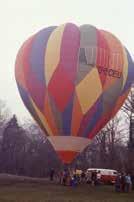

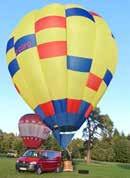



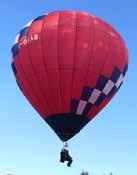
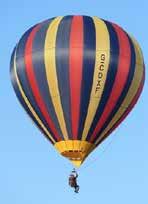
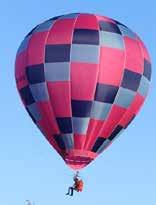



Printed by CBS World www.cbsworld.co.uk




































































